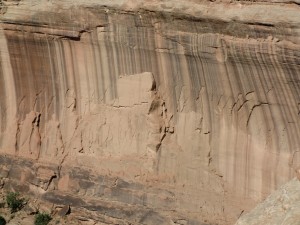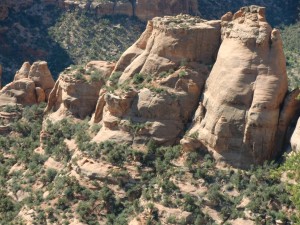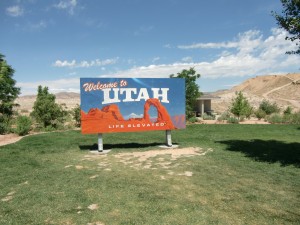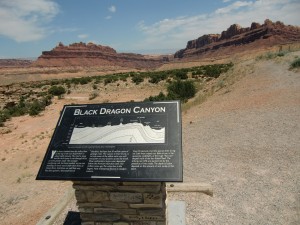THE BEST OF THE WEST – COLORADO NATIONAL MONUMENT
THE BEST OF THE WEST
This is the eleventh in a series of articles about traveling the West by bus
COLORADO NATIONAL MONUMENT
By Charles N. Stevens
Photos by Dolores Seidman
The air is clear and soda cracker-dry as we begin the day in Grand Junction, Colorado. It is the farthest west large city in the state and is almost as high as mile-high Denver at over 4500 feet. The town gets its name from the junction of two rivers, the Colorado and the Gunnison. Other than agriculture the area has substantial deposits of uranium ore as well as oil sand and shale. It’s also the center for hunters seeking mule deer or elk.
Leaving Grand Junction, we cross over the Colorado River, heading for the nearby Colorado National Monument. Ahead of us lies a high rocky mesa that, as we become closer, becomes stratified rock layers that range from reddish to buff to dark gray. We wind up into the arid mesa of towering formations and stretches of land dotted with junipers, sage and beavertail cactus. A group of bikers struggling up the grade holds our bus up for a while. We enjoy the rapidly changing scenes of color and rock formations and, as we climb higher, the sight of sparse forests of pinyon pines. Reaching our highest point at 6500 feet, we not only look deep into shadowed canyons, but also gain a hazy view of Grand Junction. Part of what we see around us reminds us of Zion National Park with its multi-colored strata.
Stopping at Artist’s Point, we have an even grander view of the bottomless canyons and great pillars of reddish rock. Each formation is a monument to time and nature. There are monstrous chimneys, towers and columns of pastel colors, all shaped into a variety of forms by wind and rain. It is a test of one’s imagination to see in them a common form—an animal, a face, a church or fortress. At the same time, far below and in the distance, are the green patchwork of farms and the orchards of Fruita.
At the visitors center we see an excellent movie about the formation of the Colorado National Monument and the way it changes through the seasons. Afterwards we stroll around the grounds enjoying the magnificent views and looking closer at the native flora—sage, Mormon tea, rabbit brush and Indian rice grass. We look out again at a formation resembling a huge coke oven and the dry sandy wash at its base.
We begin our trip down the mountain, resolved that the Colorado National Monument is a sight that no one should miss if they are near the area. We have some of our last looks at the city far below as well as the blue ribbon of the Colorado River.
Now back on Interstate 70, our bus follows along the Colorado River, cottonwoods clinging to its banks. When we pause at the Utah Port of Entry we gaze out at a prairie dog town, some peering out curiously from their burrows. A coyote lopes across a field, perhaps hunting for a prairie dog tidbit.
The landscape varies as we speed west from earth-colored rocks to stretches of brown grassland with pale green shrubs. Junipers appear anytime we increase our elevation, the zone for their growth being quite sharp. We pass mesas with talus slopes and dark colored hills. Pausing at a rest stop containing gardens of plants common to the area, we look out again on more gray mesas and low hills. The temperature is 95 degrees.
At Green River we stop at the Tamarisk Inn located next to the banks of the Colorado River. After a satisfying bowl of potato soup, Dolores and I sit on a bench outside sharing a huge cookie. The river, overflowing its banks in places, inundates some of the trees in its flood plain.
After a ride down the main street of the town of Green River, suffering since the interstate highway bypassed it, we resume traveling west on the I-70. The scene is one of sparse vegetation, land shimmering in the heat. Breaking up the sameness are the formations of Black Dragon Canyon with its tilted masses of rock, some of them looking like Vasquez Rocks in California. We watch cloud shadows play over the chaotic scene. Soon we join I-15, which will take us south toward St George, Utah where we will stay for the night.
As we travel through open farmland, cross winds buffet our bus and blowing dust obscures the scene. We pause at Richfield, Utah for a break, the wind still fierce, wind-blown dust scouring the land. I have to hold on to my cap to keep it from blowing away in the gale. Traffic signals sway and flags stand out straight, the temperature a searing 96 degrees.
In late afternoon we arrive in St. George, Utah, the wind like a blast from an oven at 107 degrees. After cooling off in our hotel rooms, we brave the wind and walk to one of the famous Cracker Barrel Inns for dinner. We enjoy its cool, homey atmosphere and feel it’s a great place to have our last dinner of the trip. Tomorrow will be the last leg of our trip back to Los Angeles covering the same territory I had described in earlier articles.
(My article next month will be the first in a series of a trip to Basel, Switzerland to begin a cruise along the Rhine and Mosel rivers.)

These massive, water-streaked cliffs are a part of the grandeur of the Colorado National Monument.

Exquisite red formations as pictured here dominate the monument.

The sign, welcoming us to Utah, ushers in some rather dry, desolate country.

Black Dragon Canyon is a chaotic display of tilted rocks.
MONTEREY PARK AUTHOR PUBLISHES 3RD BOOK ABOUT HIS EXPERIENCES IN WORLD WAR II- BACK FROM COMBAT
Charles “Norm” Stevens, a 40 year resident of Monterey Park and World War II Veteran has recently published the 3rd in his series about his experiences in WW II, Back from Combat: A WWII Bombardier Faces His Military Future. This book details the time from when he returned from combat in England where he flew 34 missions over Germany and France until the end of the war. Faced with large numbers of returning combat vets, and not knowing how long the war would continue, the military had to plan for their future. His options were whether to return to combat, become an instructor in the U.S., or receive new training that he would use in the Pacific. The book concludes with the end of the war with an Afterward that includes an update on the B-l7’s still flying in the U.S., as well as present day accounts pertaining to the war.
Stevens is the author of two previous books about his experiences:
An Innocent at Polebrook: A Memoir of an 8th Air Force Bombardier (Story of his 34 bombing missions from his base at Polebrook, England over Germany and France)
The Innocent Cadet: Becoming A World War II Bombardier (A prequel to the first, telling of his training in the U.S. before going overseas into combat.)
He is known to the readers of The Citizen’s Voice as the author of Travel Log Articles including “From Paris to Normandy on the Seine”, “Exploring New York” and “In Search of Snow.” He is retired, having taught for 32 years, primarily in the Montebello Unified School District.
Those interested in purchasing an autographed copy of any of his books, may contact the author at 323-721-8230 or Normstevens24@gmail.com.
.



